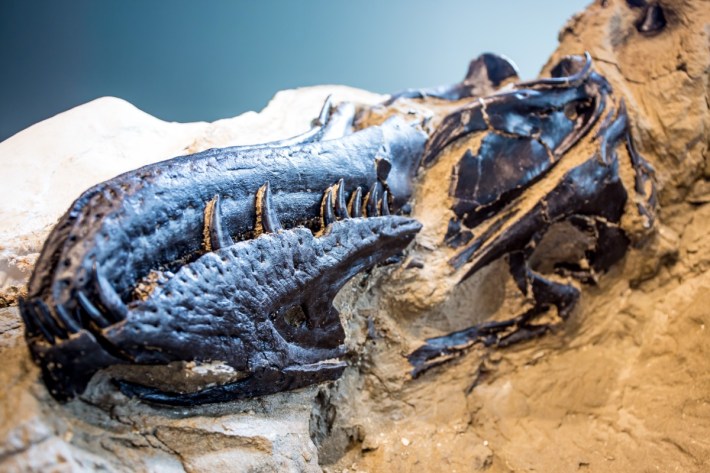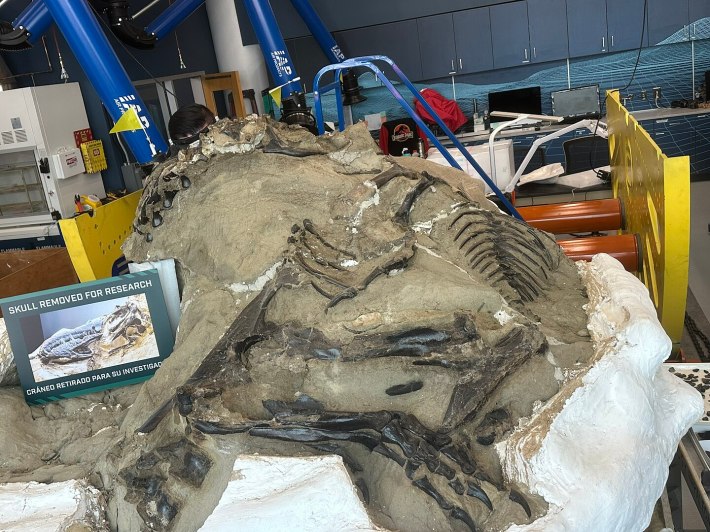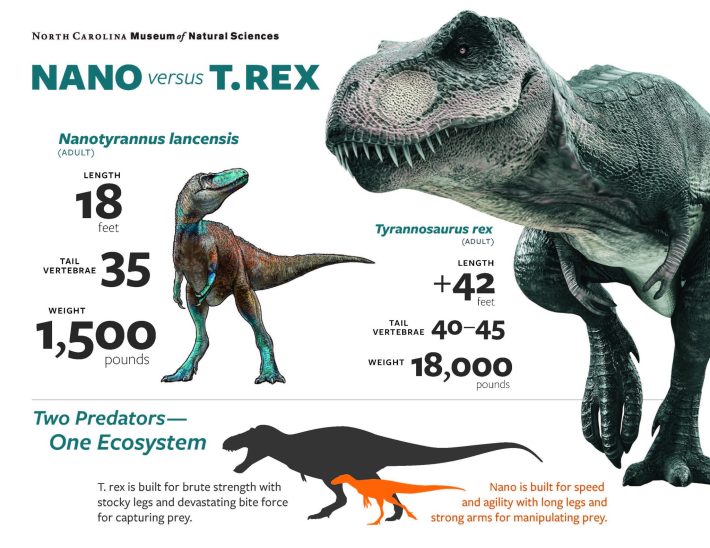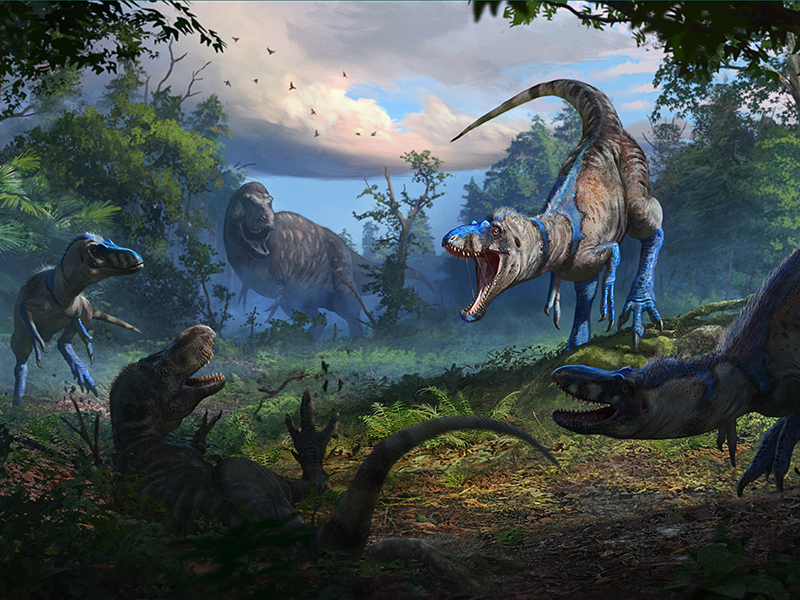For decades, paleontologists have been terrorized by the notion of a teenage Tyrannosaurus rex. Starting in the 1940s, excavations unearthed skulls belonging to what appeared to be smaller and more slender tyrannosaurs. But the scientists were sharply divided on what these skulls represented. Were they a Tween rex or a totally different dinosaur? In 1988, a group of scientists including paleontologist Philip J. Currie classified a skull of a tyrannosaur found in Montana that was approximately half as long as T. rex as a new genus and species: Nanotyrannus lancensis. In 1999, the paleontologist Thomas Carr published a rebuttal paper arguing that the specimen merely represented an adolescent T. rex.
In the years since, Nanotyrannus has been surrounded by controversy. A few scientists staunchly defended the smaller species, while most others insisted that there is no such thing as Nanotyrannus, interpreting the smaller dinos as abundant evidence of a young T. rex. Paper upon paper has come out giving evidence for either side of the debate, with none robust enough to conclusively settle it. But a study recently published in Nature and led by Lindsay Zanno, the head of paleontology at the North Carolina Museum of Natural Sciences, and James Napoli, an anatomist at Stony Brook University, contends to have ended the debate at last, ruling in favor of a second, smaller species. In other words, Nanotyrannus lives?
Claims of debate-settling science should always be taken with a grain of salt. However, the new study appears to live up to the hype. As Asher Elbein reports for The New York Times, longtime Nanotyrannus skeptics—including Carr and the paleontologists Thomas Holtz, Dave Hone, and Steve Brusatte—say they have been convinced. "The overarching mic drop of this paper is that Nanotyrannus is real, its own distinct tyrannosaur species, and that necessitates a fundamental reassessment of tyrannosaur classification and evolution," Brusatte, a paleontologist at the University of Edinburgh, wrote in an email to the Washington Post. "It’s wonderful when new evidence shows that some of our cherished notions—my cherished notions as a tyrannosaur researcher—are likely to be wrong. That’s science." In other words, Nanotyrannus lives! (Metaphorically, of course.)

Tyrannosaurus rex is no stranger to controversy, in part because of its unparalleled celebrity. The 40-something-foot-long, nine-ton predator is famous for its fearsome build, puny arms, and towering pedestal in popular culture. This mainstream fame has meant that T. rex also attracts a great deal of scientific attention. New discoveries around the species are guaranteed to make a big splash in public eye, including more radical and less robust papers that attract eye-rolling from scientists, and are often later disproven. Several years ago, when an eclectic group of researchers argued that T. rex was three separate species, their paper received widespread media coverage even though the majority of the scientific community said their claims did not hold water and eventually went on to publish a scathing refutation. (The three-species paper wisely steered clear of making a ruling on Nanotyrannus.)
Before the new Nanotyrannus paper, most researchers thought that the potential Nanotyrannus candidates represented gangly juvenile T. rexes. A Nanotyrannus was less than half as long as a T. rex and a tenth its mass, and its limbs were longer and more slender. Two of the most hotly-debated specimens, nicknamed Jane and Petey, were discovered in the early 2000s at Hell Creek. Jane and Petey were each a little bigger than a draft horse, which I have just learned is a formidably large sort of horse. Scientists found evidence of rapid growth, indicated by growth rings in their bones, suggesting the two dinos were juveniles. And Jane and Petey died at 13 and 15, about a decade before they would have reached their full size, a timeline aligned with a teenaged T. rex. This makes sense, and it put a dent in the argument for Nanotyrannus.
In the new Nanotyrannus paper, Zanno and Napoli's evidence centers on a famous fossil known as Dueling Dinosaurs, which contains the remains of a tyrannosaur (who is nicknamed "Bloody Mary" for reasons I have not been able to track down) and a Triceratops (who, rather unjustly, does not seem to have a nickname). The dinosaurs were buried 67 million years ago in Montana's Hell Creek formation and discovered in 2006 by a fossil hunter named Clayton Phipps. Their bodies are entangled in the rock, perhaps preserving a struggle between predator and prey. But scientists had not been able to study the fossil to determine if the two dinosaurs were immortalized mid-fight because Phipps couldn't find any buyers, and so the Dueling Dinos languished for years in a Long Island warehouse. After a lengthy legal process, Zanno was able to purchase the fossil for the North Carolina Museum of Natural Sciences, removing the dinosaur from private hands and ensuring it would finally be available for scientific study.

Scientists knew the slab of stone contained one nearly complete specimen of Triceratops horridus, as well as a smaller tyrannosaur widely considered to be a juvenile. But when Zanno's team began analyzing Bloody Mary, they quickly realized it could not possibly be a young T. rex. Scientists had never found the full arm of a putative Nanotyrannus until now, and the difference was obvious: Bloody Mary's arm was already longer than that of a full-grown T. rex. Its hand was bigger, too, with larger fingers and claws than the adult T. rex.

The evidence continued to pile up in favor of Nanotyrannus. When Zanno and Napoli counted the segments of Bloody Mary's tail, they found 36 vertebrae, compared to a T. rex's 40ish vertebrae. Although vertebrae can get thinner with age, they do not disappear. When they analyzed the growth rings inside Bloody Mary's bones, they found the dinosaur was 20 years old and nearly full-grown. They found more structures in Bloody Mary that do not exist in T. rex and would not have changed as the animal matured, such as a greater number of teeth, evidence of nerves in the skull, and an extra sinus cavity.
There were two possible explanations: Either the growth of an adolescent T. rex defied the rules of how vertebrates mature, or Bloody Mary represented a separate species. "For Nanotyrannus to be a juvenile T. rex, it would need to defy everything we know about vertebrate growth,” Napoli said in a statement. "It’s not just unlikely—it’s impossible." (Currie's initial 1988 paper naming Nanotyrannus highlighted the specimen's higher number of teeth as clear evidence it was another species.)
In the process of their research, Zanno and Napoli also examined more than 200 fossilized tyrannosaurs. They decided to take a closer look at Jane, the horse-sized 13-year-old tyrannosaur that other scientists had concluded was a juvenile. When they examined Jane's anatomy, they agreed that Jane was a juvenile—a juvenile Nanotyrannus, that is. They found Jane's anatomy differed enough from Bloody Mary's that they identified Jane as a whole new species, Nanotyrannus lethaeus. So the sunset of the Cretaceous in what is now North America was home to the lumbering giant T. rex as well as multiple smaller species of Nanotyrannus, each hunting and devouring prey in brutal and magnificent fashion. This opens up many new questions for paleontologists, such as how the predators coexisted or competed with each other for prey.

Although Nanotyrannus is certainly the star of the new paper, it has implications for its larger cousin. “For decades, palaeontologists have unknowingly used Nanotyrannus specimens as a model for teenage T rex to understand the biology of Earth’s most famous dinosaur—studies of its locomotion, growth, diet and life history. Those studies need a second look,” Zanno told The Guardian. Scientists will also need to reassess specimens of smaller T. rexes to see which might represent Nanotyrannus, and which might indeed represent a teenaged T. rex. Former Nanotyrannus skeptics Brusatte and Carr cautioned that the new paper does not mean that every small skeleton is a Nanotyrannus.
When the Nanotyrannus paper was published on Oct. 30, it lit up the paleontological community, many of whom already knew from the rumor mill what the paper promised to reveal. While some of the converted Nanotyrannus skeptics were excited to welcome the fun-sized tyrant into the Tyrannosaur fold, former skeptic Hone cautioned on Bluesky that the new paper was not evidence that the Nanotyrannus truthers had been right all along, as some subtweets suggested they might think. Rather, it was a case of extraordinary claims requiring extraordinary evidence. This new paper provided exactly that.
So what have we learned today? Dinosaurs remain extremely cool. Good science is always interested in correcting itself. The debate looks settled for now, though new evidence might emerge later that will once again unsettle the tyrannosaur family in ways we have not even anticipated. Bluesky must have some juice if scientists are subtweeting other scientists. And, most importantly, 67 million years ago, a pint-sized tyrannosaur scampered between the enormous thighs of a T. rex in a world where dinosaurs were flourishing, right up until the asteroid hit.







